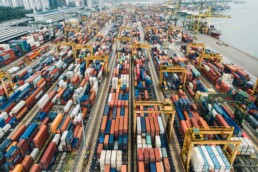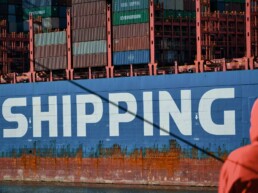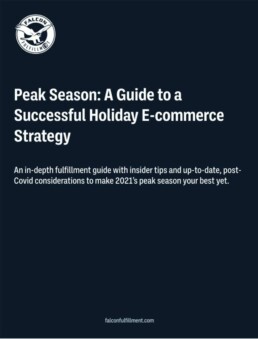The East Coast Port Strike’s Ripple Effect on U.S. Supply Chains
The ongoing East Coast Port Strike is a seismic event for U.S. supply chains, with dockworkers on the East and Gulf Coasts offloading no cargo. These ports account for more than 40% of U.S. imports, and their shutdown is causing a ripple effect across industries that depend on continuous flows of goods. From retail to manufacturing, and even the healthcare sector, businesses face critical challenges in maintaining operations and meeting consumer demand. Here’s how this labor stoppage is shaking up the supply chain—and what industries must do to adapt.

Retail Industry Braces for the Worst
The East Coast Port Strike couldn’t come at a worse time for retailers. With the holiday shopping season approaching, delayed shipments are leading to concerns about inventory shortages. This is especially true for companies relying on third-party logistics (3PL) and e-commerce fulfillment services to meet increased consumer demand. The stakes are high: empty shelves during the busiest shopping months could mean significant losses, and the additional costs of redirecting goods from East Coast ports to the West Coast or other alternatives will undoubtedly be passed on to consumers.
Meanwhile, the pressure is mounting on fulfillment services. Accurate inventory management and seamless order fulfillment solutions will be crucial as retailers scramble to adjust. Supply chains are designed for efficiency, not flexibility, and with warehousing and distribution already stretched, it’s likely that many retailers will miss out on opportunities to capitalize on the season. Same-day and next-day delivery services could also be threatened as disruptions pile up. Expect delays, frustrated customers, and climbing costs as the strike continues.
Manufacturing Faces Critical Delays
The manufacturing sector is also grappling with significant disruptions. Many manufacturers rely on supply chain management systems that depend on the timely arrival of raw materials, including steel and electronics components. The East Coast Port Strike has already put a wrench in these plans. Factories operating on vendor-managed inventory (VMI) systems are particularly vulnerable, as they depend on just-in-time deliveries to keep production lines moving.
With cross-docking becoming more challenging due to port shutdowns, businesses will need to turn to alternative options like freight forwarding and bulk shipping to keep materials flowing. The costs associated with these alternatives are rising, further complicating an already strained supply chain. Moreover, manufacturers relying on warehouse automation and precise inventory forecasting now find themselves in a position where the data can’t predict what’s next. This level of uncertainty could lead to production slowdowns, increased lead times, and higher prices for consumers down the road.
To minimize the fallout, manufacturers are looking at strategies like reverse logistics and freight consolidation, but even these measures have limits when international trade is involved. The East Coast Port Strike isn’t just delaying parts; it’s stalling the entire manufacturing process, causing economic ripples that could take months or even years to fully resolve.
The Healthcare Sector’s Supply Chain Stress
In the healthcare industry, the East Coast Port Strike is more than an inconvenience—it’s a matter of public health. Pharmaceutical imports, including essential medications like insulin, pass through the affected ports. With containers sitting idle, hospitals and pharmacies face serious risks of medication shortages, which could impact patient care.
Logistics in this sector depend heavily on precise order tracking and management, and disruptions in shipping and delivery could result in delayed or missed shipments of critical supplies. Customs brokerage services, crucial for clearing pharmaceuticals and medical devices through ports, are now facing backlogs, exacerbating the delay. This puts even greater pressure on healthcare providers who rely on inventory tracking software to maintain accurate records of available products.
Furthermore, any delays in kitting and assembly for medical devices could disrupt the availability of life-saving equipment. As hospitals and care providers brace for longer wait times, the situation highlights the critical need for flexibility and contingency planning within the healthcare supply chain.
Adaptation Is Crucial
The East Coast Port Strike is forcing industries to rethink their logistics strategies. Diversifying multi-channel fulfillment options is becoming a necessity for businesses looking to stay competitive. Some are turning to air freight and alternative sea routes, though these come with their own set of challenges and increased costs. Companies with international operations are leveraging shipment consolidation and freight consolidation to reduce overhead and shipping times, but there’s only so much that can be done without access to key ports.
Investing in more robust transportation management systems (TMS) is another option. Enhanced carrier selection and management allows businesses to pivot more effectively in the face of disruption. In addition, companies that operate fulfillment centers can tap into value-added services (VAS) to meet demand and maintain service levels, despite the strike.
Many companies are now focused on scalable fulfillment solutions that can expand or contract depending on shifting demand. But the truth is that no single solution can fully mitigate the effects of the East Coast Port Strike. The complexities of today’s supply chains mean that businesses will need to deploy a combination of these strategies to survive.
Long-Term Implications
The East Coast Port Strike isn’t just a short-term disruption; its effects will likely last well beyond the resolution of the labor dispute. In the future, companies will need to reassess their logistics infrastructure and supply chain optimization strategies. Investing in 3PL technology solutions can provide more control over critical functions, such as freight rate negotiation, that are essential during times of disruption.
Companies will also need to pay more attention to order fulfillment metrics and reporting to gain real-time insights into supply chain performance. In addition, businesses should consider improving safety and security measures in warehousing to ensure they can handle future challenges with greater agility. Ensuring order accuracy and quality control in the midst of shipping delays will also be vital to maintaining customer satisfaction.
Beginner’s Guide to Third-Party Logistics (3PL)
The world of e-commerce is always changing, therefore understanding the roll of Third-Party Logistics is integral to keeping up. In light of this our beginner’s guide to third-party logistics (3PL) will delve into the essential aspects, offering insights into fulfillment services, warehousing, and much more.
Read More…
There’s no doubt that the East Coast Port Strike has already sent shockwaves through U.S. supply chains, with major implications for industries ranging from retail to healthcare. Businesses need to act decisively to minimize the impact, deploying strategies like freight consolidation, cross-docking, and enhanced TMS to maintain the flow of goods. Those that adapt quickly will be better positioned to weather this storm and future disruptions.
Wondering how the strike can effect your supply chain?
Let’s Talk!
Peak Season: A Guide to a Successful Holiday Ecommerce Strategy
An in-depth fulfillment guide with insider tips and up-to-date, post-Covid considerations to make 2021’s peak season your best yet.






